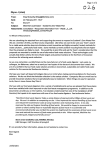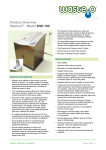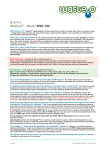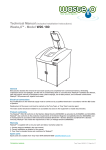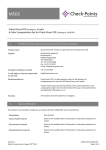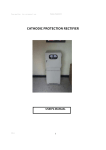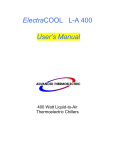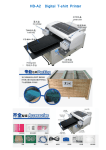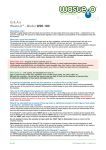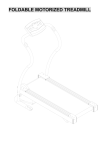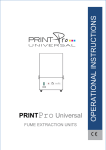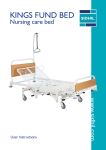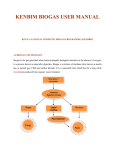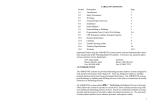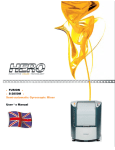Download Waste 2.0 User Manual
Transcript
User Manual Waste20TM - Model W20.180 Thank you for purchasing a Waste20 WT0.180 food waste digester. If correctly installed and operated, the digester will provide many years of service. What does it do? Waste20 rapidly digests soft food waste and converts it into grey water which runs away to drain - simply throw in the food and walk away. The process is called aerobic digestion, and a naturally occurring blend of microorganisms help with this process. What can I put in the machine? The machine will take soft organic food waste such as fruit, vegetables, cooked and uncooked meat, fish and so on. For a full list of what can be processed by the machine, please refer to the table on page 4 of this manual. The general rule is that if a human can eat the food, the Waste20 can process the food. The machine and the microorganisms are designed to process a wide range of food waste types in mixed quantities. If your operation disposes of a large quantity of one type of food waste, contact Mechline for advice before operating the machine. What can’t I put in the machine? The machine cannot process anything that is not organic food waste and cannot be easily broken down such as bones, seeds and stones, flower stems, packaging, general waste, cutlery, crockery etc. For a full list of what can be processed by the machine, please refer to the table on page 4 of this manual. The general rule is that if a human cannot eat the product, then Waste20 cannot process the product. This is important because placing the wrong products into the machine could cause damage and could void the warranty. If anything accidentally drops into the machine, is it safe to fish it out by hand? Yes. There is a paddle mechanism inside the machine that slowly rotates to stir the food waste, but this automatically stops as soon as the machine lid is opened. Rubber gloves should always be worn when retrieving anything from inside the machine. How much organic food waste can I put in the machine? Mechline Developments Ltd Unit 15 Carters Lane Kiln Farm Milton Keynes MK11 3ER T: +44 (0) 1908 261 511 F: +44 (0) 1908 261 522 E: [email protected] www.mechline.com Dimensions shown in mm unless otherwise stated. Information and numerical data has been prepared as a general guide to the products but intending buyers & users must satisfy themselves as to the suitability and safety of the products for their particular purposes & duties. No responsibilities are assumed for errors herein. The company reserves the right to alter designs and specifications of the products without notice. Operators can continually “top up” the machine with food waste - up to 45kgs at any one time. A general rule-of-thumb is to fill up to the axle. Much like the human digestive system, the machine gradually processes the food. Trying to put too much food waste into the machine at one time will overload the machine and slow the process. The machine can process a maximum of 180kgs of organic food waste over a 24-hour period. USER MANUAL Revision: 01/2011 l Page 1 of 7 Waste20 - Model: W20.180 Waste20 - Model: W20.180 The Waste20 can process approximately 45 Kg of organic food waste every 6 hours. Temperature is important. In order to maximise the performance of the machine, the chamber temperature must be maintained at between approximately 40°C and 45°C. Do not place large quantities of chilled or frozen food in the chamber. Do not store food waste outdoors in winter months. What if my operation has a period of the day when a significant amount of organic food waste is produced - lunchtime for example? This is very common and is easily overcome by scheduling the loads of food waste put into the machine. Food waste in excess of what the machine can process at any one time should be stored ready to be put into the machine later in the day once the machine has had a chance to process what it already holds. If the Waste20 control panel’s amber ‘WAIT’ light is on, the machine has sensed that it is working at full capacity. Note that the Waste20 lid will automatically lock while the ‘WAIT’ light is on. As soon as the machine has digested some of its load, the ‘WAIT’ light will go out and the machine lid will automatically unlock. Do not attempt to force the machine lid open while the ‘WAIT’ light is illuminated. Doing so could void the machine warranty. Operational tip: Every time the Waste20 lid is opened, a small amount of power, water and microorganism is used. Try to minimise the number of times the machine lid is opened by keeping a sealable food waste bucket by the machine. Open the machine lid and pour the food waste in only when the bucket is full. How do I put food waste into the Waste20? Simply open the machine lid and pour the food waste through the hatch onto the woodchips inside, then close the lid. Revision: 01/2011 l Page 2 of 7 USER MANUAL USER MANUAL Revision: 01/2011 l Page 7 of 7 Waste20 - Model: W20.180 Waste20 - Model: W20.180 Appliance care What if the red ‘SERVICE’ light flashes? The ‘SERVICE’ light will flash and the alarm will sound if the machine shaft becomes jammed. If this happens, open the machine lid and remove the cause of the jam. Rubber gloves should be worn for this operation. The machine shaft will not run until the lid has been closed. The machine should be regularly wiped down using a disposable cloth and plain water. Do not use bleach or other harsh cleaning chemicals. Never pour floor washing or cleaning water into the machine as the presence of cleaning agents may kill the microorganisms. Do not turn off the power or water supply to the Waste20. The machine should be left running. Important safety information This Waste20 appliance is not to be used by children or persons with reduced physical, sensory or mental capabilities, or lack of experience and knowledge, unless they are given adequate supervision or instruction. Children should not be allowed to play with the appliance. Do not use this appliance to dispose of hard materials such as glass and metal. Switch off or unplug the appliance before attempting to free a jammed rotor with an implement. What if there is a power cut, or someone turns off the power to the machine, or someone presses the emergency knock-off button? Waste20 will not automatically restart. Once the power is restored, follow the procedure: 1. Turn the isolator on the front of the machine to the ‘ON’ position. 2. Ensure the emergency knock-off switch is pulled out. 3. Press the green ‘RESTART’ button on the control panel. The machine will now restart. NOTE: The ‘WAIT’ light will illuminate and the lid will remain locked for 20 minutes while the machine warms up. After 20 minutes the machine can be used in the normal way. What if the machine is left unused for a long period of time? If the Waste20 machine is not used (lid is not opened) for 96 hours (4 days and nights,) it automatically reverts to ‘ENERGY-SAVING’ mode. Opening and closing the lid will return the machine to normal running mode. NOTE: If the machine is not used (lid is not opened) for 1 month, the microorganisms inside the machine chamber will die. In this situation a ‘BOOSTER PACK’ of microorganism must be added to the machine chamber before the machine is used. ‘Booster packs’ can be purchased from Mechline 01908 261511. What goes in: What stays out: Soft organic material such as ● Meats (cooked or uncooked) ● Fish ● Vegetables ● Pasta, Noodles, bread crumbs, rice ● Fruit ● The machine and the microorganisms are designed to process a wide range of food waste types in mixed quantities. If your operation disposes of a large quantity of one type of food waste, contact Mechline for advice before operating the machine. ● Revision: 01/2011 l Page 4 of 7 ● ● ● ● ● Meat and fish bones Raw dough, flours Pineapple tops Fruit & vegetable seeds and stones such as mango, avocado, peach etc. Corn Husks, Flower stems Oil, fats, soups Frozen or chilled food (wait until room temperature) USER MANUAL USER MANUAL Revision: 01/2011 l Page 5 of 7 Waste20 - Model: W20.180 Waste20 - Model: W20.180 A copy of this document is also included with each master box of fluid. Why are there woodchips in the machine? Waste20 Fluid - MATERIAL SAFETY DATA SHEET The woodchips are impregnated with specially blended microorganisms that break up the food waste. The woodchips remain in the machine all of the time and only need topping up every 12 months. Mechline will contact you 12 months after your Waste20 has been installed to arrange for more woodchips to be delivered. In compliance with Regulation (EC) No. 1907/2006 (REACH) Can I put refrigerated or frozen food waste into the Waste20? 1. IDENTIFICATION OF THE SUBSTANCE / PREPARATION AND OF THE COMPANY UNDERTAKING Commercial product name: Waste 2.0 Fluid Description: An aqueous odour counteracting spray. Distribution: Mechline Developments Ltd, 15 Carters Lane, Kiln Farm, Milton Keynes, MK11 3ER T: 01908 261511 F: 01908 261522 E: [email protected] 10. STABILITY AND REACTIVITY Material is stable under normal conditions of use Conditions to avoid: Excessive temperature variations, below 0°C or above 45°C. Materials to avoid: Strong acids or alkali and strong oxidizing agents. Shelf life: 18 months 2. HAZARDS IDENTIFICATION Excessive ingestion may cause nausea or diarrhoea. May be irritant to skin and eyes. Preparation does not present a danger to the environment. 11. TOXICOLOGICAL INFORMATION Acute toxic effects: Not determined. Skin irritation: Not expected. Eye irritation: Not expected. The bacteria in the product are all naturally occurring and are known to be non-pathogenic to humans, animals or plants. 3. COMPOSITION / INFORMATION ON INGREDIENTS Chemical composition: An aqueous solution containing naturally occurring micro-organisms, odour absorber, biodegradable chelating agent/surfactant and preservative CAS No. Not applicable, product is a preparation Classification/symbol: Not classified as hazardous Contains: Cas No. Concentration Hazard Symbol Alcohol 67-63-0 <5% F Xi; R11, R36, R37 4. FIRST AID MEASURES Skin contact: Wash off with plenty of water. Eye contact: Wash immediately with copious quantities of water. Ingestion: Rinse mouth and throat and drink water to dilute. Inhalation: Not applicable. If symptoms persist seek medical advice 5. FIRE FIGHTING MEASURES Suitable fire fighting extinguishing media: Any Non-suitable media: None Special exposure hazards: None Protection against fire and explosions: Not applicable 6. ACCIDENTAL RELEASE MEASURES Personal precautions: Refer to section 8. Environmental precautions: Avoid uncontrolled excessive release to drains. The product contains natural bacterial strains to break down cellulose, fats, oils and greases, proteins and starch through enzymatic metabolism. Clean-up procedures: Small releases should not pose any hazard to the local environment. Wash spillage site with water. 7. HANDLING AND STORAGE Handling requirements: The material should be handled under good housekeeping practices. Wash hands after use. Keep away from drinking water sources. Storage conditions: Store in a cool and dry place. Avoid freezing temperatures and temperatures above 45°C to preserve biological stability. Packaging materials: Packaging can be recycled. 12. ECOLOGICAL INFORMATION Mobility: The preparation is highly dispersible in water and has a low vapor pressure. Product is likely to distribute predominantly to the aqueous environment. Persistence and degradability: The preparation is not harmful to the environment and does not present any dangers in terms of persistency and degradability. Accumulation: Preparation is not expected to bioaccumulate due to high water solubility. Ecotoxicity: The preparation has been formulated to cause minimal environmental impact and is not anticipated to pose any environmental hazard. Other adverse effects: Adverse effects in the sewage treatment plant are not anticipated. Other information: Contains Class 1 microorganisms selected from the natural environment. 15. REGULATORY INFORMATION EC Regulations: This preparation does not meet the criteria for classification as dangerous in accordance with Directive 1999/45/EC. There are no special labelling requirements. No hazard symbol, R or S phrases are required for labelling, in accordance with CHIP 3 regulations. 9. PHYSICAL AND CHEMICAL PROPERTIES Appearance: Slightly Cloudy liquid Odour: Characteristic pH: 9.0-9.5 Solubility in water: Soluble Boiling Point: Not applicable Melting Point / Flash Point / Flammability: Not applicable Vapour Pressure (mm Hg): as for H2O Specific Gravity: 1.01 The information contained in this Safety Data Sheet, as of the issue date, is believed to be true and correct. However, the accuracy of completeness of this information and any recommendations or suggestions, are made without warranty or guarantee. Since the conditions of use are beyond the control of our company, it is the responsibility of the user to determine the conditions of safe use of this product. Date of preparation: 17/09/10 Issue No: 1 Page 6 of 7 No. All of the organic food waste will be digested by the machine and will run away to drain as grey water. The only items that will need removing from the machine from time to time are non-digestible items that are accidentally put into the machine. Is there anything else I need to do to keep the Waste20 machine running? Yes. You must ensure that there is always a box of Waste20 microorganism in the machine and that the box is properly connected. This is essential because every time the machine hatch is opened a tiny amount of the microorganism is sprayed onto the food waste. If the microorganisms are not regularly topped up in this way, they will eventually die out and the machine will not be able to function. If the machine lid is opened approximately 25 times per day, the fluid box will last approximately 30 days. If the lid is opened more frequently, the fluid box will require replacing sooner. The microorganisms have been specially blended for this application and are perfectly safe. The Material Safety Data Sheet for the microorganisms is included with each master box, and there is a copy in the user’s manual for your records. 14. TRANSPORT INFORMATION International Regulations Land: Not applicable. Inland waterways: Not applicable. Sea: Not applicable. Air: Not applicable. 16. OTHER INFORMATION Explanation of risk phrases that appear on the MSDS but do not need to appear on the product label: R11 Flammable R36/37 Irritating to eyes and respiratory system l Is there any sludge or by-product for me to get rid of? 13. DISPOSAL CONSIDERATIONS Disposal operations: Dispose of in accordance with local regulations. Disposal of packaging: Empty packaging can be recycled. 8. EXPOSURE CONTROLS/PERSONAL PROTECTION Personal Protective Equipment Respiratory protection: Not required Hand protection: Gloves recommended Eye Protection: Recommended when handling large quantities Revision: 01/2011 No. Please allow for the food waste to come to room temperature before adding. If very cold food waste is added it will change the conditions in the chamber and could kill the microorganisms that break up the food waste. USER MANUAL When the fluid requires replacing, the blue ‘REPLACE FLUID’ light on the control panel will flash and a buzzer alarm will sound. NOTE: If the fluid is not replaced within 72 hours of the alarm sounding, the lid will automatically lock, and will not release until the fluid box is replaced. Follow the replacement instructions on the fluid box. Contact Mechline for replacement fluid 01908 261511. Always keep a spare box in stock. NOTE: There is no need to turn off the power in order to open the LEFT hand door and change the fluid box. USER MANUAL Revision: 01/2011 l Page 3 of 7




